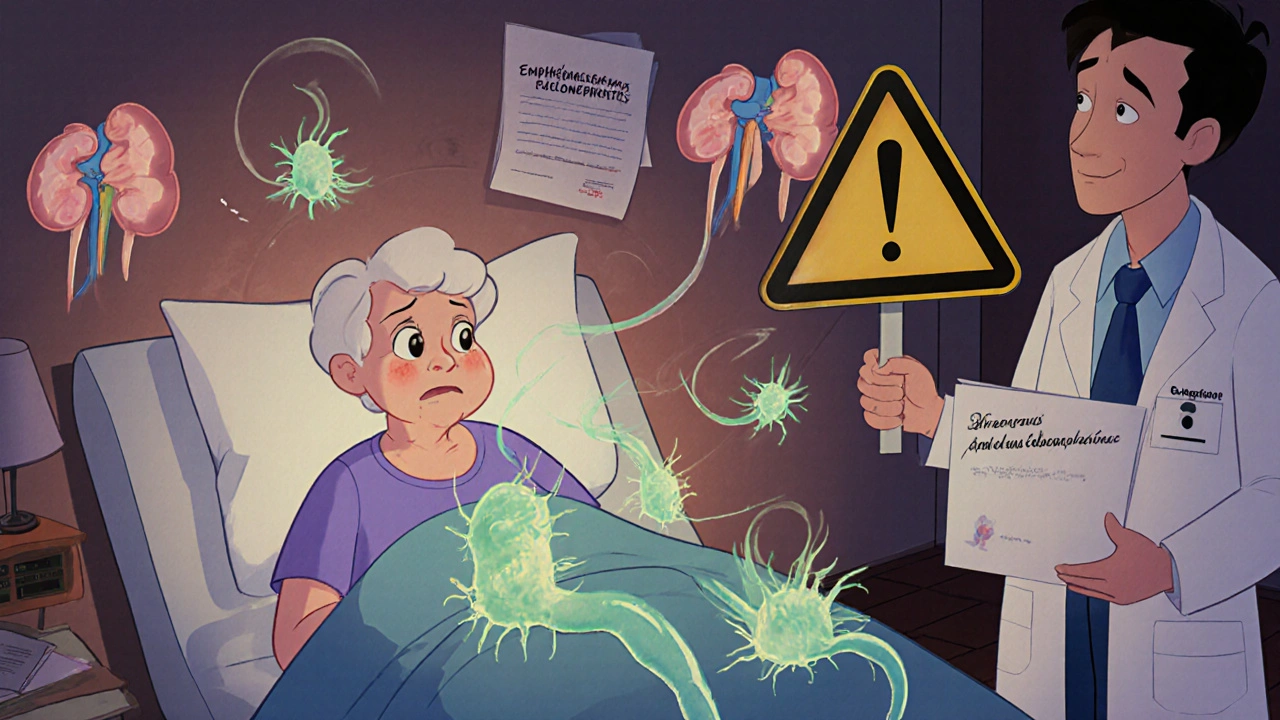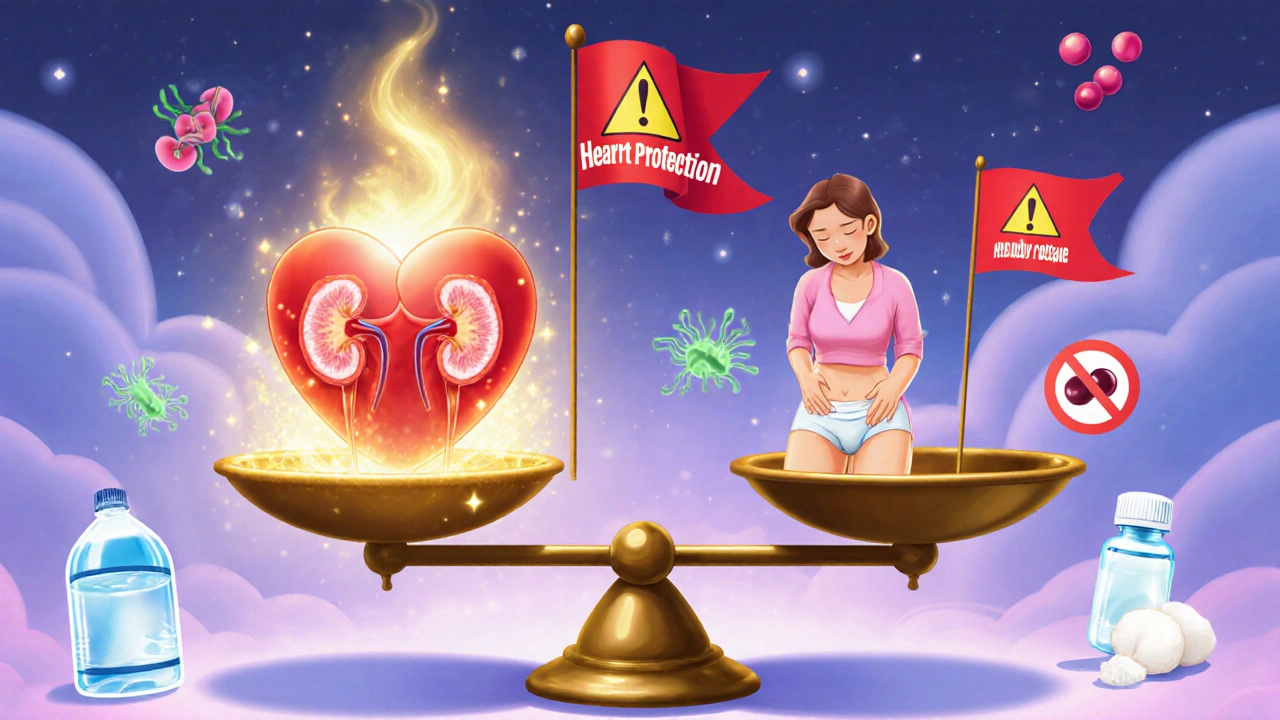Why SGLT2 Inhibitors Can Cause Yeast Infections
When you take an SGLT2 inhibitor for type 2 diabetes, your body starts flushing out extra sugar through your urine. That’s how these drugs lower blood sugar - by making your kidneys dump glucose instead of reabsorbing it. Sounds smart, right? But here’s the catch: sugar in your urine doesn’t just disappear. It becomes food for yeast and bacteria, especially in warm, moist areas like the genitals and urinary tract.
This isn’t a rare side effect. About 3 to 5 out of every 100 people taking SGLT2 inhibitors like dapagliflozin, empagliflozin, or canagliflozin get a genital yeast infection within the first few months. For women, that usually means itching, redness, and thick white discharge - classic signs of vulvovaginal candidiasis. For men, it’s often balanitis: swelling, redness, and discomfort around the head of the penis. These infections aren’t usually dangerous on their own, but they’re annoying, recurrent, and often the first warning sign of something worse.
The Real Danger: When Infections Turn Serious
Most people think a yeast infection is just a nuisance. But with SGLT2 inhibitors, what starts as a mild itch can spiral into something life-threatening. The FDA has documented cases where patients developed urosepsis - a bloodstream infection that begins in the urinary tract. Between 2013 and 2014 alone, 19 patients on SGLT2 inhibitors were hospitalized with urosepsis. Four needed intensive care. Two needed dialysis because their kidneys failed.
One case from the National Institutes of Health tells the full story: a 64-year-old woman developed emphysematous pyelonephritis - a rare, gas-forming kidney infection - while on dapagliflozin. She needed surgery, 14 days of IV antibiotics, and later had a recurrence after restarting the drug. She said, “I never had urinary problems before this medication, and now I’ve had two life-threatening infections.” That’s not an outlier. Studies show SGLT2 inhibitors increase the risk of urinary tract infections by nearly 80% compared to other diabetes drugs like DPP-4 inhibitors.
Who’s Most at Risk?
Not everyone on SGLT2 inhibitors gets infections - but some people are far more likely to. If you’re a woman over 50, have had urinary tract infections before, or have diabetes that’s poorly controlled (HbA1c over 8.5%), your risk jumps significantly. People with kidney problems (eGFR below 60), older adults, and those with weakened immune systems are also at higher risk.
A 2024 study in Diabetes Care created a simple 5-point risk score to predict who’s most vulnerable:
- Age over 65
- Female sex
- HbA1c above 8.5%
- History of prior urinary tract infections
- Estimated glomerular filtration rate (eGFR) below 60 mL/min
If you score 3 or more points, your chance of a serious urinary infection is over 15%. That’s not a small risk - it’s a red flag.

How These Drugs Compare to Other Diabetes Medications
Let’s be clear: SGLT2 inhibitors aren’t the only diabetes drugs with side effects. But their infection risk is unique. Other classes like metformin or DPP-4 inhibitors don’t cause sugar to spill into urine. So they don’t create the same breeding ground for yeast.
Here’s how SGLT2 inhibitors stack up:
| Medication Class | Genital Infection Risk | UTI Risk | Key Advantages |
|---|---|---|---|
| SGLT2 inhibitors | 3-5% | 1.7x higher than DPP-4 inhibitors | Heart and kidney protection, weight loss |
| DPP-4 inhibitors | 1-2% | Baseline | Low infection risk, neutral weight effect |
| Sulfonylureas | 1-2% | Similar to DPP-4 | Low cost, strong glucose lowering |
| GLP-1 receptor agonists | 1-2% | Similar to DPP-4 | Heart protection, weight loss, low hypoglycemia risk |
If you’ve had recurrent UTIs or yeast infections in the past, switching to a DPP-4 inhibitor or GLP-1 agonist might be safer. These drugs still help with blood sugar and heart health - without turning your urine into a yeast buffet.
What to Do If You’re Already on an SGLT2 Inhibitor
If you’re taking one of these drugs and you’re not having problems, don’t panic. But do stay alert. The biggest mistake people make is ignoring early symptoms. A little itching? A new urge to pee more often? A slight burning? Don’t wait. Don’t assume it’s “just a yeast infection” and reach for an over-the-counter cream. That can delay treatment and let the infection spread.
Here’s what to do right away:
- Drink more water - at least 2 liters a day. It flushes sugar out faster.
- Wipe front to back after using the toilet.
- Avoid scented soaps, douches, or tight synthetic underwear.
- Check your genitals daily for redness, swelling, or unusual discharge.
- Call your doctor immediately if you have a fever above 100.4°F, pain in your lower back or sides, or feel generally unwell.
Some research suggests cranberry supplements might reduce UTI risk by 29% in people on SGLT2 inhibitors. It’s not a cure, but it’s a low-risk, low-cost option worth discussing with your doctor.

When to Consider Stopping or Switching
For many people, the heart and kidney benefits of SGLT2 inhibitors outweigh the infection risks. If you’ve had a heart attack, have heart failure, or have diabetic kidney disease, these drugs can literally save your life. But if you’re healthy otherwise and just need to control your blood sugar, there are safer alternatives.
Consider switching if:
- You’ve had two or more yeast or UTI infections in the past year
- You’re a woman with recurrent vaginal infections
- You have kidney disease or are over 65
- You’re on multiple medications and can’t keep track of symptoms
Switching to a GLP-1 agonist like semaglutide or a DPP-4 inhibitor like sitagliptin can give you similar glucose control without the infection risk. And unlike older drugs like sulfonylureas, they don’t cause dangerous low blood sugar.
What Your Doctor Should Be Asking You
Good doctors don’t just prescribe SGLT2 inhibitors and move on. They screen. They educate. They follow up.
Before starting you on one, your doctor should ask:
- Have you ever had a yeast infection, UTI, or kidney infection?
- Do you have any structural issues with your urinary tract?
- Are you on any other medications that affect your immune system?
- Can you recognize early symptoms and know when to call for help?
And after you start: they should check in at 1 month, 3 months, and then every 6 months. If you’re not being asked these questions, it’s time to speak up.
The Bigger Picture: Benefits vs. Risks
Let’s not forget why SGLT2 inhibitors became so popular. In large trials, empagliflozin reduced the risk of heart-related death by 38% in people with heart disease. Canagliflozin cut the risk of kidney failure by 30%. These aren’t small wins - they’re life-changing.
But medicine isn’t about choosing between perfect and bad. It’s about choosing the best option for you. If you’re a 70-year-old man with heart failure and no history of infections, SGLT2 inhibitors might be your best shot. If you’re a 45-year-old woman with three UTIs last year, you might be better off with something else.
The goal isn’t to scare you off these drugs. It’s to make sure you’re not just a statistic - you’re a person with a unique body, history, and risk profile. Your treatment should match that.

Comments
Shawna B
So sugar in pee = yeast party? That’s wild. I didn’t know my meds were basically feeding fungi.
On November 15, 2025 AT 14:16
Sophia Lyateva
they say its the drugs but i bet its the water fluoridation + 5g of sugar in every processed snack. they dont want you to know this. 🤫
On November 15, 2025 AT 23:46
Victor T. Johnson
I’ve been on empagliflozin for 2 years and never had a single issue. 🙌 My HbA1c’s at 5.8 and my kidneys are happy. If you’re getting infections, maybe check your hygiene, not the med. 🍑
On November 16, 2025 AT 05:48
Lyn James
People today just want a magic pill that fixes everything without consequences. You want to lower blood sugar? Eat less sugar. Stop blaming Big Pharma for your lack of discipline. This is what happens when you outsource your health to a prescription. 🤦♀️
On November 17, 2025 AT 23:47
Craig Ballantyne
The risk-benefit calculus here is non-trivial. SGLT2i confer significant CV and renal protection in high-risk cohorts, with NNH for genital mycotic infection approximately 33. For patients with established ASCVD or HFrEF, the NNT for hard endpoints is <10 over 3 years. The UTI risk, while elevated, is largely manageable with hydration and hygiene protocols. Discontinuation should be individualized, not reflexive.
On November 18, 2025 AT 20:15
David Ross
I've had 3 UTIs in 10 months since starting canagliflozin. I didn't think it was connected until I read this. Now I'm scared. My doctor just said 'it's common' and gave me more antibiotics. That's not enough. This is a systemic failure.
On November 20, 2025 AT 07:55
Nicholas Swiontek
I’m on dapagliflozin too and had a yeast infection at month 2. I started drinking 3L of water a day, switched to cotton underwear, and stopped using scented soap. No more issues. It’s not the drug-it’s how you manage it. You got this 💪
On November 20, 2025 AT 08:52
Jerry Ray
You’re all acting like this is some new conspiracy. My grandpa was on insulin in the 80s and got infections every winter. Sugar in urine = bad. Always has been. The real question is why we’re still surprised by basic biology.
On November 20, 2025 AT 20:40
Krys Freeman
This is why America’s healthcare is broken. You get a pill for everything instead of learning to eat right. Just stop eating carbs and you won’t need this junk.
On November 22, 2025 AT 09:25
AARON HERNANDEZ ZAVALA
I think we’re missing the point. These drugs save lives. But we need better education. Not everyone knows what 'itching' means in this context. Doctors need to sit down and explain it like you’re talking to a friend, not a textbook. Maybe then fewer people get scared or ignored symptoms.
On November 22, 2025 AT 13:39
Melania Dellavega
I’m a nurse and I’ve seen this over and over. A woman comes in with a yeast infection, gets treated, goes back on the drug, and it happens again. No one ever connects the dots. We treat the symptom, not the cause. We’re not teaching patients how to think about their meds-we’re just handing out prescriptions and hoping for the best. It breaks my heart. We need better follow-ups. We need to ask: ‘Has anything changed since you started this?’ And then LISTEN.
On November 23, 2025 AT 10:50
Bethany Hosier
Did you know that the FDA’s database shows 87% of SGLT2 inhibitor-related urosepsis cases were missed in initial visits? The system is designed to ignore early warnings. This isn’t negligence-it’s institutionalized denial. The same companies that market these drugs also fund the guidelines that downplay the risks. They don’t want you to know how easy it is to prevent this. They want you dependent. And they’re winning.
On November 23, 2025 AT 13:31
Robert Asel
The assertion that cranberry supplements reduce UTI risk by 29% in this population is not supported by randomized controlled trials of sufficient power. The 2024 Diabetes Care risk score, while statistically significant, lacks external validation in diverse cohorts. Furthermore, the comparison table omits confounding variables such as concurrent antibiotic use and catheterization rates, which are significant predictors of UTI incidence. One must exercise caution before altering therapeutic regimens based on observational data.
On November 25, 2025 AT 11:01